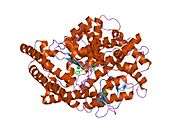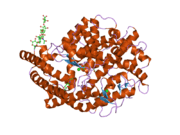| Angiotensin I converting enzyme |
|---|
|

|
| Available structures |
| PDB |
Ortholog search: PDBe, RCSB |
| List of PDB id codes |
|
1O86, 1O8A, 1UZE, 1UZF, 2C6F, 2C6N, 2IUL, 2IUX, 2OC2, 2XY9, 2XYD, 2YDM, 3BKK, 3BKL, 3L3N, 3NXQ, 4APH, 4APJ, 4BXK, 4BZR, 4BZS, 4C2N, 4C2O, 4C2P, 4C2Q, 4C2R, 4CA5, 4CA6
|
|
|
| Identifiers |
|---|
| Symbols |
ACE ; ACE1; CD143; DCP; DCP1; ICH; MVCD3 |
|---|
| External IDs |
OMIM: 106180 MGI: 87874 HomoloGene: 37351 ChEMBL: 1808 GeneCards: ACE Gene |
|---|
| EC number |
3.4.15.1 |
|---|
|
|
| RNA expression pattern |
|---|
|
|
|
More reference expression data |
| Orthologs |
|---|
| Species |
Human |
Mouse |
|---|
| Entrez |
1636 |
11421 |
|---|
| Ensembl |
ENSG00000159640 |
ENSMUSG00000020681 |
|---|
| UniProt |
P12821 |
P09470 |
|---|
| RefSeq (mRNA) |
NM_000789 |
NM_001281819 |
|---|
| RefSeq (protein) |
NP_000780 |
NP_001268748 |
|---|
| Location (UCSC) |
Chr 17:
63.48 – 63.5 Mb |
Chr 11:
105.97 – 105.99 Mb |
|---|
| PubMed search |
|
|
|---|
|
Angiotensin-converting enzyme (EC 3.4.15.1), or "ACE" indirectly increases blood pressure by causing blood vessels to constrict. It does that by converting angiotensin I to angiotensin II, which constricts the vessels. For this reason, drugs known as ACE inhibitors are used to lower blood pressure.
ACE is also known by the following names: dipeptidyl carboxypeptidase I, peptidase P, dipeptide hydrolase, peptidyl dipeptidase, angiotensin converting enzyme, kininase II, angiotensin I-converting enzyme, carboxycathepsin, dipeptidyl carboxypeptidase, "hypertensin converting enzyme" peptidyl dipeptidase I, peptidyl-dipeptide hydrolase, peptidyldipeptide hydrolase, endothelial cell peptidyl dipeptidase, peptidyl dipeptidase-4, PDH, peptidyl dipeptide hydrolase, and DCP.
ACE, angiotensin I and angiotensin II are part of the renin-angiotensin system (RAS), which controls blood pressure by regulating the volume of fluids in the body. ACE is secreted in the lungs and kidneys by cells in the endothelium (inner layer) of blood vessels.[1]
Functions

Anatomical diagram of the renin-angiotensin system, showing the role of ACE at the lungs.
[2]It has two primary functions:
These two actions make ACE inhibition a goal in the treatment of conditions such as high blood pressure, heart failure, diabetic nephropathy, and type 2 diabetes mellitus. Inhibition of ACE (by ACE inhibitors) results in the decreased formation of angiotensin II and decreased metabolism of bradykinin, leading to systematic dilation of the arteries and veins and a decrease in arterial blood pressure. In addition, inhibiting angiotensin II formation diminishes angiotensin II-mediated aldosterone secretion from the adrenal cortex, leading to a decrease in water and sodium reabsorption and a reduction in extracellular volume.[5]
Kininase II is the same as angiotensin-converting enzyme. Thus, the same enzyme (ACE) that generates a vasoconstrictor (ANG II) also disposes of vasodilators (bradykinin).[6]
Genetics and C and N domains function
The ACE gene, ACE, encodes two isozymes. The somatic isozyme is expressed in many tissues, mainly in the lung, including vascular endothelial cells, epithelial kidney cells, and testicular Leydig cells, whereas the germinal is expressed only in sperm. Brain tissue has ACE enzyme, which takes part in local RAAS and converts Aβ42 (which aggregates into plaques) to Aβ40 (which is thought to be less toxic) forms of beta amyloid. The latter is predominantly a function of N domain portion on the ACE enzyme. ACE inhibitors that cross the blood–brain barrier and have preferentially select N terminal activity may, therefore, cause accumulation of Aβ42 and progression of dementia.
Pathology
- Elevated levels of ACE are found in sarcoidosis, and are used in diagnosing and monitoring this disease. Elevated levels of ACE are also found in leprosy, hyperthyroidism, acute hepatitis, primary biliary cirrhosis, diabetes mellitus, multiple myeloma, osteoarthritis, amyloidosis, Gaucher disease, pneumoconiosis, histoplasmosis, miliary tuberculosis.
- Serum levels are decreased in renal disease, obstructive pulmonary disease, and hypothyroidism.
Influence on athletic performance
- ACE gene is a I/D polymorphism leading to the presence(I) or absence (D) the carriers of the ACE insertion allele of an alu repeat in intron 16 of the gene.[7] With the insertion, observed higher maximum oxygen uptake (VO2max), increase in training, and increased muscle when paired with individuals carrying the deletion allele.
- Individuals with the insertion are associated with long distance and endurance events. This is seen in studies that suggest that it is due to lower levels of angiotensin II. The deletion of the Alu increases angiotensin II that in turn increases the vasoconstriction of blood vessels. This is observed in short distance events and seen mostly in swimmers.[8]
See also
References
- ↑ Kierszenbaum, Abraham L. (2007). Histology and cell biology: an introduction to pathology. Mosby Elsevier. ISBN 0-323-04527-8.
- ↑ Page 866-867 (Integration of Salt and Water Balance) and 1059 (The Adrenal Gland) in: Walter F., PhD. Boron (2003). Medical Physiology: A Cellular And Molecular Approaoch. Elsevier/Saunders. p. 1300. ISBN 1-4160-2328-3.
- ↑ Zhang R, Xu X, Chen T, Li L, Rao P (May 2000). "An assay for angiotensin-converting enzyme using capillary zone electrophoresis". Anal. Biochem. 280 (2): 286–90. doi:10.1006/abio.2000.4535. PMID 10790312.
- ↑ Imig JD (March 2004). "ACE Inhibition and Bradykinin-Mediated Renal Vascular Responses: EDHF Involvement". Hypertension 43 (3): 533–5. doi:10.1161/01.HYP.0000118054.86193.ce. PMID 14757781.
- ↑ Klabunde RE. "ACE-inhibitors". Cardiovascular Pharmacology Concepts. cvpharmacology.com. Retrieved 2009-03-26.
- ↑ Boron and Boulpaed Medical Physiology 2nd edition Updated
- ↑ Wang P, Fedoruk MN, Rupert JL (2008). "Keeping pace with ACE: are ACE inhibitors and angiotensin II type 1 receptor antagonists potential doping agents?". Sports Med 38 (12): 1065–79. doi:10.2165/00007256-200838120-00008. PMID 19026021.
- ↑ Costa AM, Silva AJ, Garrido ND, Louro H, de Oliveira RJ, Breitenfeld L (August 2009). "Association between ACE D allele and elite short distance swimming". Eur. J. Appl. Physiol. 106 (6): 785–90. doi:10.1007/s00421-009-1080-z. PMID 19458960.
Further reading
- Niu T, Chen X, Xu X (2002). "Angiotensin converting enzyme gene insertion/deletion polymorphism and cardiovascular disease: therapeutic implications". Drugs 62 (7): 977–93. doi:10.2165/00003495-200262070-00001. PMID 11985486.
- Roĭtberg GE, Tikhonravov AV, Dorosh ZhV (2004). "[Role of angiotensin-converting enzyme gene polymorphism in the development of metabolic syndrome]". Ter. Arkh. 75 (12): 72–7. PMID 14959477.
- Vynohradova SV (2005). "[The role of angiotensin-converting enzyme gene I/D polymorphism in development of metabolic disorders in patients with cardiovascular pathology]". Tsitol. Genet. 39 (1): 63–70. PMID 16018179.
- König S, Luger TA, Scholzen TE (2006). "Monitoring neuropeptide-specific proteases: processing of the proopiomelanocortin peptides adrenocorticotropin and alpha-melanocyte-stimulating hormone in the skin". Exp. Dermatol. 15 (10): 751–61. doi:10.1111/j.1600-0625.2006.00472.x. PMID 16984256.
- Sabbagh AS, Otrock ZK, Mahfoud ZR, et al. (2007). "Angiotensin-converting enzyme gene polymorphism and allele frequencies in the Lebanese population: prevalence and review of the literature". Mol. Biol. Rep. 34 (1): 47–52. doi:10.1007/s11033-006-9013-y. PMID 17103020.
- Castellon R, Hamdi HK (2007). "Demystifying the ACE polymorphism: from genetics to biology". Curr. Pharm. Des. 13 (12): 1191–8. doi:10.2174/138161207780618902. PMID 17504229.
- Lazartigues E, Feng Y, Lavoie JL (2007). "The two fACEs of the tissue renin-angiotensin systems: implication in cardiovascular diseases". Curr. Pharm. Des. 13 (12): 1231–45. doi:10.2174/138161207780618911. PMID 17504232.
External links
PDB gallery |
|---|
| | 1o86: CRYSTAL STRUCTURE OF HUMAN ANGIOTENSIN CONVERTING ENZYME IN COMPLEX WITH LISINOPRIL. |
| 1o8a: CRYSTAL STRUCTURE OF HUMAN ANGIOTENSIN CONVERTING ENZYME (NATIVE). |
| 1uze: COMPLEX OF THE ANTI-HYPERTENSIVE DRUG ENALAPRILAT AND THE HUMAN TESTICULAR ANGIOTENSIN I-CONVERTING ENZYME |
| 1uzf: COMPLEX OF THE ANTI-HYPERTENSIVE DRUG CAPTOPRIL AN THE HUMAN TESTICULAR ANGIOTENSIN I-CONVERTING ENZYME |
| 2c6f: STRUCTURE OF HUMAN SOMATIC ANGIONTENSIN-I CONVERTING ENZYME N DOMAIN |
| 2c6n: STRUCTURE OF HUMAN SOMATIC ANGIONTENSIN-I CONVERTING ENZYME N DOMAIN WITH LISINOPRIL |
| 2iul: HUMAN TACE G13 MUTANT |
| 2iux: HUMAN TACE MUTANT G1234 |
| 2oc2: Structure of testis ACE with RXPA380 |
|
|
|
|
|---|
| | 1-50 | |
|---|
| | 51-100 | |
|---|
| | 101-150 | |
|---|
| | 151-200 | |
|---|
| | 201-250 | |
|---|
| | 251-300 | |
|---|
| | 301-350 | |
|---|
|
|
|---|
| | Activity | |
|---|
| | Regulation | |
|---|
| | Classification | |
|---|
| | Types | |
|---|
|











